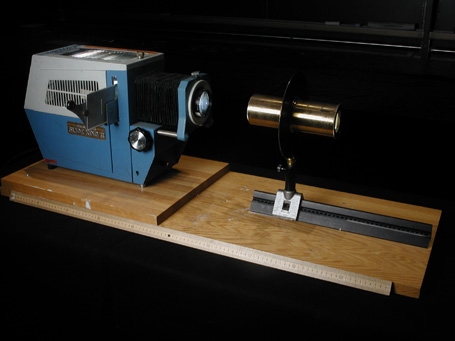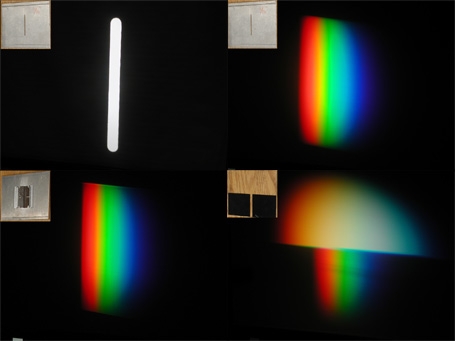What it shows:
White light is shown, á la Newton's demonstration of dispersion by a prism, to be composed of a continuous spectrum of colors.
How it works:
A large brilliant spectrum is produced by using a 1 kW carbon arc light source 1 with adjustable slit, a "fast" f/0.9 imaging lens, 2 and a highly dispersive in-line prism. 3 The spectrum easily fills a two meter wide screen with vibrant colors. An alternative (more compact) setup consists of a Beseler slide projector 4 which has a 1 kW incandescent lamp and, of course, all the imaging optics built right in. The same in-line prism is used as with the carbon arc. The resulting spectrum is not quite as brilliant as the carbon arc source.
Setting it up:
The large carbon arc requires 3-phase 208 VAC power. Set it off to one side of the lecture hall and position the projection screen at a 45° angle on the opposite side. The imaging lens and prism are mounted on the optics rail which is an integral part of the carbon arc. Adjust the slit width to about 2 mm. Focus the slit on the screen with the imaging lens and then position the prism as close as possible to the lens. Re-adjust the slit width for the desired effect or compromise (a narrow slit produces purer colors at the expense of intensity).


If the slide projector is to be used, set it on a cart positioned somewhere in the middle of the floor space as its intensity is not sufficient to brilliantly illuminate the screen from across the whole floor. Two "slides" are available to give the desired effect. (The slides are made from 1/16" thick aluminum sheet cut to the standard 3.25" × 4" size and have slits milled into them: 1/8" (3.2 mm) and 1/16" (1.6 mm) in width.)
Comments:
Beautiful spectrum! Because the dispersion is a function of frequency, the blue end of the spectrum is much more spread out than the red.
1 Peerless MAGNARC, Mftd. by The Strong Electric Corp., Toledo Ohio.
2 Physitec quartz lens; 56 mm f.l. and 63 mm diam. The fact that it's quartz is not important for this application - the low f number is important.
3 PH. PELLIN, Mon Jules DuBosco - Paris. This beautiful priceless antique piece of optics is encased in brass, has a 64 mm diam. aperture, and is 203 mm long. We also have a modern Amici prism approximately half this size in all dimensions. Again, the issue here is: large aperture = bright image.
4 Slide King II, Charles Beseler Co., East Orange, N.J.